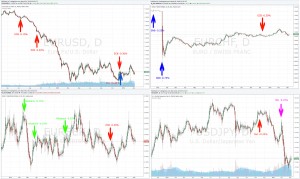Fed Rates – Prospects of USD/INR Carry
| 09-09-2016 | Rahul Magan |
 “Federal Reserve Rates and INR Reverse Carry”. As we understand that Federal Reserve Chairman Janet Yellen turning Hawkish and asking for 25 Bps increase in September 2016. If we look carefully then Fed vice Chair Fisher also suggested the same and at the same time most prominent Bond Trader – Bill Gross also suggested increase of 25 Bps in September and 25 Bps in December. If this would happen then Overnight Rates of USD would move to 1% and this would be closer to Australia which is 1.5% in $ terms.
“Federal Reserve Rates and INR Reverse Carry”. As we understand that Federal Reserve Chairman Janet Yellen turning Hawkish and asking for 25 Bps increase in September 2016. If we look carefully then Fed vice Chair Fisher also suggested the same and at the same time most prominent Bond Trader – Bill Gross also suggested increase of 25 Bps in September and 25 Bps in December. If this would happen then Overnight Rates of USD would move to 1% and this would be closer to Australia which is 1.5% in $ terms.
We should also appreciate the fact that both Central Bank of Australia and Reserve Bank of India are moving towards Accommodative Monetary Policy. This way they would decrease the interest rates as to stimulate their economy. In that regards there are millions of thoughts but in my view Accommodative Monetary Policy is a big suicide as Japanese is a perfect example in that regards. They are doing QQE since last 2 decades but at the end need to depend upon Helicopter Money to stimulate their economy?? We all understand that Helicopter Money is nothing but Explicit Debt Monetization by BOJ for Govt of Japan.
There are multiple reports which suggest that Helicopter Money has already started in the form of Helicopter Drops by BOJ for Govt of Japan. This would surely create Reverse carry for USD/INR. We all understand that Indian Central Bank – Reserve Bank of India is now following Accommodative Monetary Policy henceforth there is a big pressure on RBI to cut present Repo Rates of 6.5% by at least 100 Bps to 5.5%. This would surely decrease the carry of INR for all Foreign Institutional Investors (FII), Foreign Portfolio Investors (FPI) to invest funds in India.
One more fact which matters is the growing relevance of Indonesia where in 10 Y G Sec is trading at 7.7% and Singapore who would like to increase overnight rate to 1.35 %. If this would happen then all the funds which are scheduled to India would invest in United States who is offering 1% , Australia 1.5% , Indonesia 7.7% and upcoming Carry Currencies like Singapore offering 1.34%.
We also need to appreciate the fact that Carry Traders needs big return and specially at that time when Japanese , Swiss , Europe is in negative and also big banks like Royal Bank of Scotland , Bank of Ireland and Deutsche is asking big clients to pay negative collateral. Sitting today we are having “Quest for Yield Hunt”.
Reserve Bank of India should be well aware of the fact that if they would reduce Repo Rate by 100 Bps to 5.5% then probability of having INR moving towards Reverse Carry is 100%. This won’t appreciate INR rather would depreciate the same as less $ would park in India. We also understand that this would also increase the reliance of Indian Corporates on External Commercial Borrowings (ECB) and there would be very less funding covering Foreign Currency Non Resident Bonds (FCNR) in India which would have reciprocal impact on both USD/INR Interest Rate Swaps (IRS) and Overnight Index Swaps (OIS)
On the 5th of September 2016 Bank of Japan Governor Kuroda said there is still a big for Qualitative Quantitative Easing (QQE) in Japanese Economy however this time Negative Interest Rates would play a very important role in that regards. Keeping all the aforesaid factors, Currency Traders are advised to take care of the same while making trading bets involving INR. Currency Traders are advised to have Options Structures to hedge their exposures.
[separator type=”” size=”” icon=””]
 Rahul Magan – Chief Executive Officer Treasury Consulting LLP
Rahul Magan – Chief Executive Officer Treasury Consulting LLP
[button url=”http://www.treasuryxl.com/community/experts/rahul-magan/” text=”View expert profile” size=”” type=”primary” icon=”” external=”1″]













